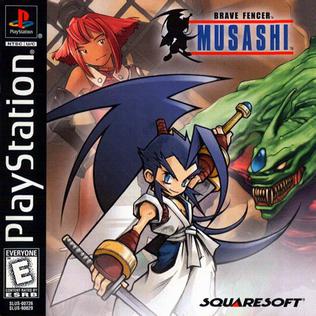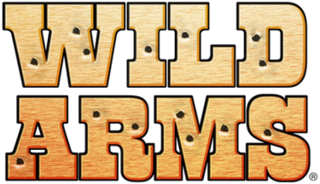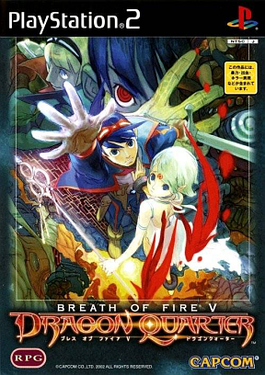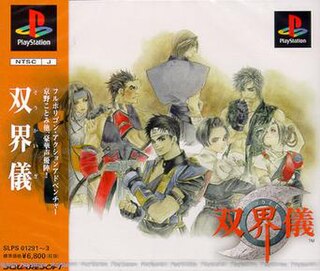
The Mana series, known in Japan as Seiken Densetsu, is a high fantasy action role-playing game series created by Koichi Ishii, with development formerly from Square, and is currently owned by Square Enix. The series began in 1991 as Final Fantasy Adventure, a Game Boy handheld side story to Square's flagship franchise Final Fantasy. The Final Fantasy elements were subsequently dropped starting with the second installment, Secret of Mana, in order to become its own series. It has grown to include games of various genres within the fictional world of Mana, with recurring stories involving a world tree, its associated holy sword, and the fight against forces that would steal their power. Several character designs, creatures, and musical themes reappear frequently.

Brave Fencer Musashi is an action role-playing video game developed and published by Square in 1998 for the PlayStation home console. The game involves real-time sword-based combat in a 3D environment; it also features segments of voiced over dialogue and role-playing game elements such as a day-night cycle and resting to restore energy.

Drakengard, known in Japan as Drag-On Dragoon, is a 2003 action role-playing video game developed by Cavia and published by Square Enix for the PlayStation 2. The game is the first installment of the Drakengard series and features a mixture of ground-based hack-and-slash, aerial combat, and role-playing elements which have become a staple of the series. The story is set during a religious war between two factions—the Union and the Empire—with the war tipping in favor of the Empire. The player controls Caim, a deposed prince of the Union, in his quest for vengeance against the Empire. Wounded in battle while protecting his sister Furiae, he is forced to make a pact with a red dragon named Angelus as they journey together on a quest to prevent the Empire from destroying magical seals that keep the world in balance.

Wild Arms, also written as Wild ARMs, is a media franchise developed by Media.Vision and owned by Sony Computer Entertainment. The franchise consists of several role-playing video games and related media. Since the launch of the original Wild Arms title in 1996, the series has gone on to encompass several media, including toys, manga, mobile phone applications, and a 22-episode anime.

Star Ocean: The Second Story, known in Japan as Star Ocean: Second Story, is an action role-playing video game developed by tri-Ace and published by Enix for the PlayStation. It is the second game in the Star Ocean series and the first game in the series to be released outside Japan, arriving in North America in June 1999 and Europe in April 2000, by Sony Computer Entertainment. Taking place in a science fantasy universe, the story centers around a young man named Claude C. Kenny, a cadet from a space-faring Earth organization who is stranded on an undeveloped, medieval-level planet. There, he meets several companions and must stop a plot from an evil organization that spans multiple worlds before finding his way home. The game was the basis of manga and anime adaptations.

Ogre Battle: The March of the Black Queen is a 1993 real-time tactical role-playing game developed by Quest Corporation. Originally published for Super NES by Quest in Japan and by Enix America in North America. It is the first installment of the Ogre Battle series. It was directed by Yasumi Matsuno, and designed by Matsuno with Akihiko Yoshida. The story of Ogre Battle focuses on a band of rebels as they lead a revolution against a corrupt reigning Empire, ruled by an evil Empress.

Legend of Mana is a 1999 action role-playing game developed and published by Square for the PlayStation. It was the fourth game released in the Mana series, following 1995's Trials of Mana. Set in a high fantasy universe, the game follows an unnamed hero as they restore the land of Fa'Diel by creating the world around them and completing a number of interrelated quests in order to restore the Tree of Mana.

SaGa Frontier 2 is a role-playing video game developed and published by Square for the PlayStation. It is the eighth original game in their SaGa series. Initially released in Japan in April 1999, an English version was made available in North America in February 2000 by Square Electronic Arts and in PAL regions the following March by Square. Development for the title was headed by series creator Akitoshi Kawazu, with music by Masashi Hamauzu. The game features an art style unique to the series at the time it was released, utilizing hand-painted watercolor backdrops and characters to give the game a storybook feel. Like other SaGa games, gameplay is largely non-linear, giving the player multiple paths to follow in order to complete the game.

Breath of Fire: Dragon Quarter is a 2002 role-playing game by Capcom for the PlayStation 2. It is the fifth entry in the Breath of Fire series.

Soukaigi is a 1998 action role-playing game developed by Yuke's and published by Square for the PlayStation. It was later re-released digitally for the PlayStation Portable, PlayStation 3 and PlayStation Vita. No version of the game was localized. Set in modern-day Japan, Soukaigi follows a group of five people chosen by the gods to save Japan from a supernatural catastrophe. Gameplay has each character navigating levels, fighting monsters and completing required tasks to advance the story.

Dark Cloud is an action role-playing video game developed by Level-5 and published by Sony Computer Entertainment for the PlayStation 2. Originally intended as a launch title for the system in March 2000, the game was eventually released in Japan in December 2000, in North America in May 2001, and in Europe in September. A spiritual sequel, Dark Chronicle, was released in Japan in 2002 and worldwide the following year.
Albums for the video game Wild Arms contain music from the original title of the Wild Arms series developed by Japanese software company Media.Vision. Two separate albums, one released alongside the 1996 PlayStation game, and the other ten years later, contain the original background music from the game, while a single drama album contains a spoken-word interpretation of events in the game. All music featured on each album was composed by Michiko Naruke and carries a contemporary American Western feel intermixed with electronic instrumentation. As each album was only released commercially in Japan, track names contain original Japanese character names and spelling.
The music of the video game Final Fantasy III was composed by regular series composer Nobuo Uematsu. Final Fantasy III Original Sound Version, a compilation of almost all of the music in the game, was released by Square Co./NTT Publishing in 1991, and subsequently re-released by NTT Publishing in 1994 and 2004. The soundtrack to the remake of Final Fantasy III for the Nintendo DS, Final Fantasy III Original Soundtrack was released by NTT Publishing in 2006, with revamped versions of the tracks and additional tracks. A vocal arrangement album entitled Final Fantasy III Yūkyū no Kaze Densetsu, or literally Final Fantasy III Legend of the Eternal Wind, contained a selection of musical tracks from the game. The tracks were performed by Nobuo Uematsu and Dido, a duo composed of Michiaki Kato and Shizuru Ohtaka. The album was released by Data M in 1990 and by Polystar in 1994.

Memories Off 5: Togireta Film is a Japanese romance visual novel developed by KID and published by CyberFront for the PlayStation 2 console. It was released on October 27, 2005, and is the fifth game in the Memories Off series. A port for the PlayStation Portable handheld developed and published by 5pb. was released on January 29, 2009. A sequel named Memories Off 5: Encore was released for the PlayStation 2 on July 12, 2007. Its PlayStation Portable port was released on September 17, 2009. The gameplay of Memories Off 5 follows linear plot line, which offers different pre-determined scenarios and events, and focuses on the appeal of the five female main characters.

Final Fantasy XIV is a massively multiplayer online role-playing game (MMORPG) developed and published by Square Enix. Directed and produced by Naoki Yoshida and released worldwide for PlayStation 3 and Windows in August 2013, it replaced the failed 2010 version, with subsequent support for PlayStation 4, macOS, PlayStation 5, and Xbox Series X/S. Final Fantasy XIV is set in the fantasy region of Eorzea, five years after the devastating Seventh Umbral Calamity which ended the original version. In the Calamity, the elder primal Bahamut escaped from his prison, an ancient space station called Dalamud, unleashing an apocalypse across Eorzea. Through temporal magic, the player character of the original version escaped, reappearing at the start of A Realm Reborn. As Eorzea cements its recovery, the player must fend off a reignited invasion from the Garlean Empire.

Drakengard 3, known in Japan as Drag-On Dragoon 3, is an action role-playing video game developed by Access Games and published by Square Enix exclusively for PlayStation 3. It is the third main game in the Drakengard series and a prequel to the original game. The game, like the rest of the series, features a mixture of ground-based hack-and-slash combat and aerial battles. The story focuses on Zero, a woman who can manipulate magic through song. Partnering with a dragon named Mikhail, Zero set out to kill her five sisters, who rule the world's regions. As she travels, the player discovers the true reason behind Zero's rampage.
Drakengard, known in Japan as Drag-On Dragoon, is a series of action role-playing video games created by Yoko Taro. The eponymous first game in the series was released in 2003 on the PlayStation 2, and has since been followed by a sequel, a prequel and several spin-offs. A spin-off series titled Nier, taking place in an alternative timeline set after a different ending to the first Drakengard than the one 2005's Drakengard 2 followed, was started in 2010 with the eponymous game. Yoko directed every game in both series, with the exception of Drakengard 2 in which he only had minor involvement.
The music for the Drakengard series, known as Drag-On Dragoon in Japan, has been handled by multiple composers since the release of the original game in 2004. Drakengard's composers were Nobuyoshi Sano and Takayuki Aihara, Drakengard 2 was handled by Ryoki Matsumoto and Aoi Yoshiki, and Drakengard 3 was composed for by Keiichi Okabe, the composer for series spin-off Nier. Sano remained as a sound director for the second game, and his music was used as a reference for the third. Multiple albums have been released for the music of the series: Drag-On Dragoon Original Soundtrack Vol.1 and Vol.2 were released on October and November 2004, while a two-disc re-release titled Drag-On Dragoon Original Soundtrack was released in April 2011. The Drag-On Dragoon 2 Original Soundtrack was released on July 20, 2005. A promotional disc with two tracks from the soundtrack was released in the same year. The official soundtrack for the third game, Drag-On Dragoon 3 Original Soundtrack, was released January 21, 2014. A compilation of chiptune remixes of the previous games and Nier, Drag-On Dragoon Chips Music, was released on December 19, 2013 as part of the Drag-On Dragoon 10 Anniversary Box.

Final Fantasy XIV: Heavensward is the first expansion pack to Final Fantasy XIV: A Realm Reborn, a massively multiplayer online role-playing game (MMORPG) developed and published by Square Enix for macOS, PlayStation 3, PlayStation 4, and Windows, then later on PlayStation 5 and Xbox Series X/S. It was released on June 23, 2015, nearly two years after the debut of A Realm Reborn. Naoki Yoshida served as director and producer and Nobuo Uematsu, who had not worked on the title since the ill-fated 2010 launch of the original Final Fantasy XIV, returned to collaborate with Masayoshi Soken on the soundtrack. The expansion pack was released as a standalone product for current players, as well as an "all-in-one" bundle containing A Realm Reborn and Heavensward. The latter was the only way to access the OS X version of the game, which premiered on the same day as the expansion pack's launch.

God Wars: Future Past is a tactical role-playing game developed by Kadokawa Games, and published by NIS America outside of Japan. The original version of the game was released in June 2017 for the PS4 and PS Vita. An expanded version of the game, God Wars: The Complete Legend, was released worldwide on the Nintendo Switch on September 4, 2018. The expanded version was also released on PS4 and PS Vita exclusively in Japan.


















